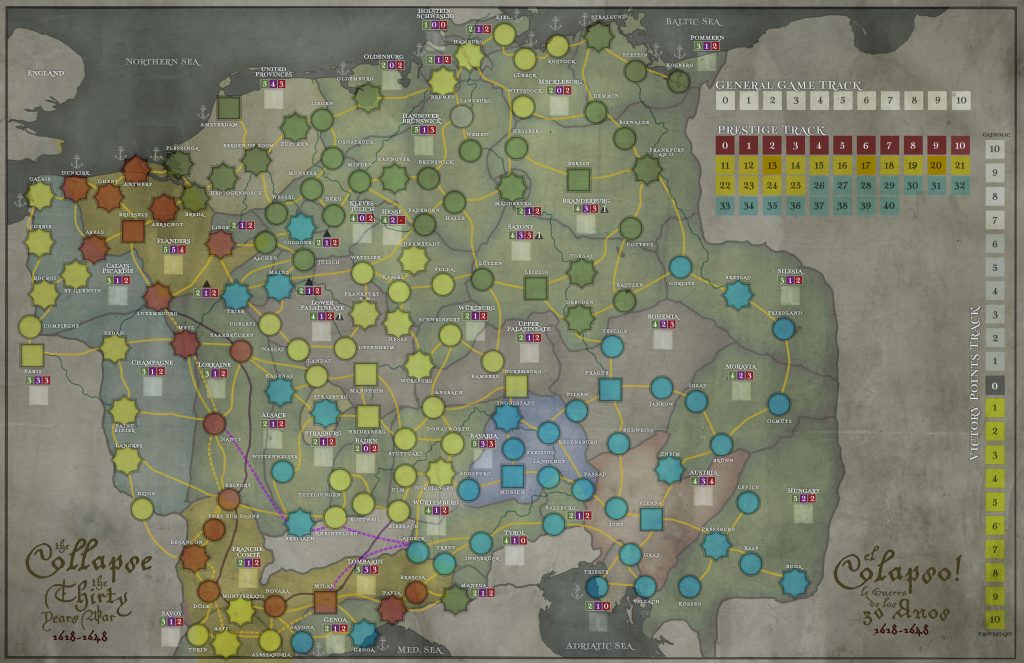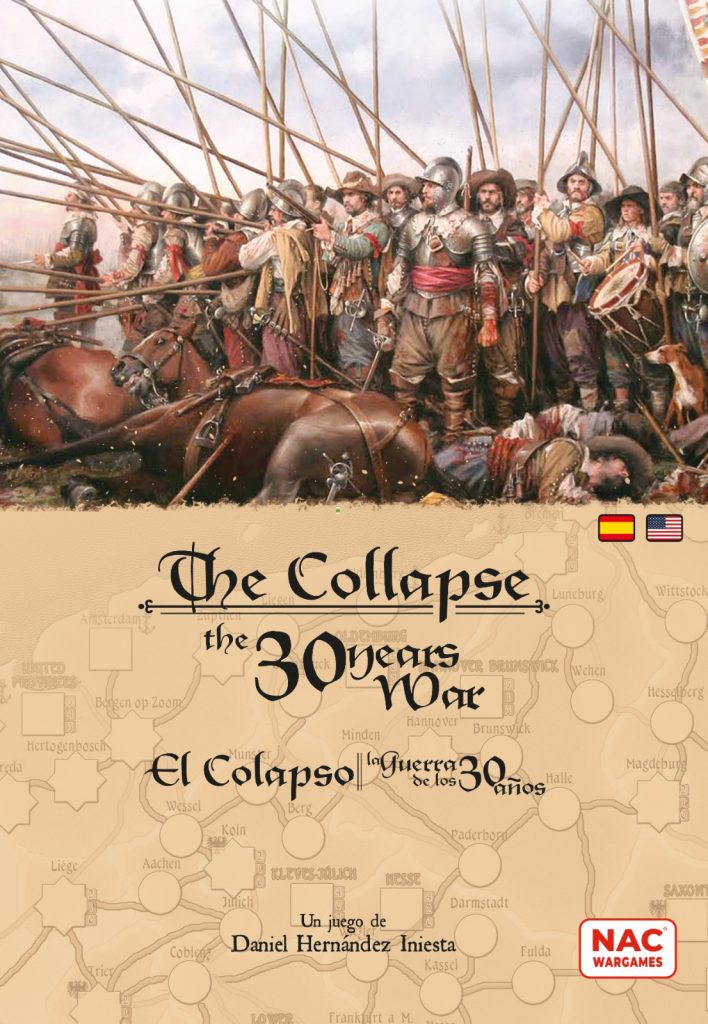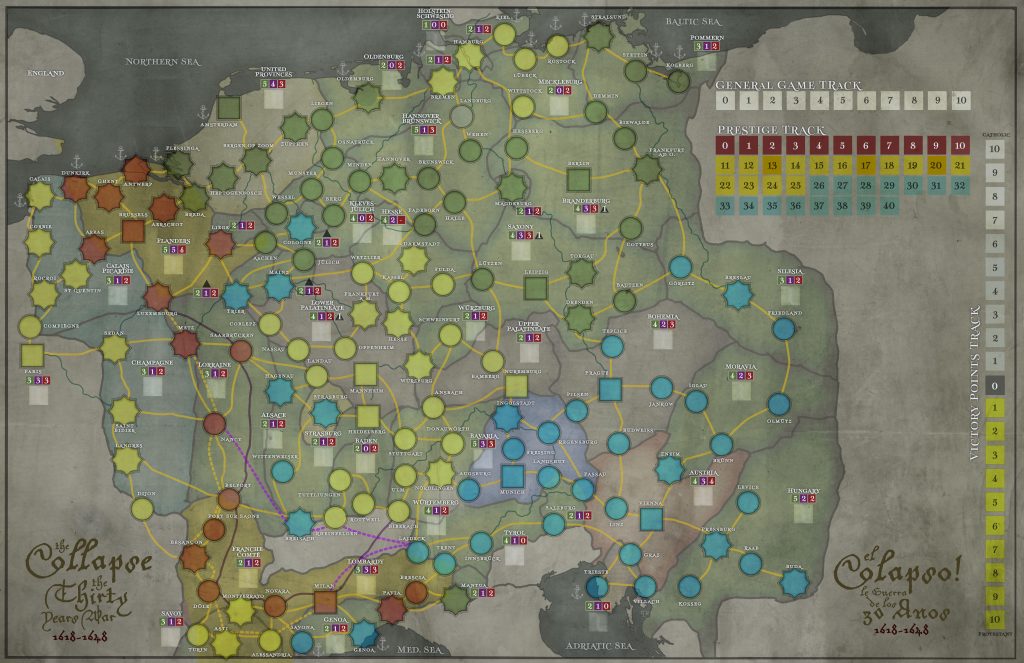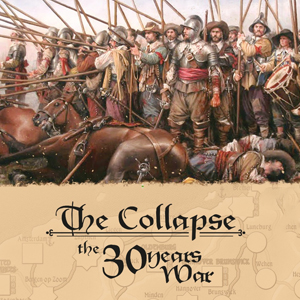For the article information in English, please scroll down
1. Introducción a la guerra de los 30 años
La Guerra de los Treinta Años fue un conflicto del siglo XVII que se libró principalmente en Europa Central y llegó hasta Flandes y el norte de Italia. Sigue siendo una de las guerras más largas y brutales de la historia de la humanidad, con más de 8 millones de víctimas de las batallas militares, así como de la hambruna, los estragos y las enfermedades resultantes del conflicto. La guerra duró de 1618 a 1648, comenzando como una lucha entre los estados católicos y protestantes que formaron el ‘Sacro Imperio Romano Germánico’. Sin embargo, a medida que evolucionó la Guerra de los Treinta Años, se convirtió menos en religión y más en quién gobernaría Europa en última instancia. Al final, el conflicto cambió el rostro geopolítico de Europa, el papel de la religión y el lugar de los estados-nación en la sociedad.

2. Facciones
- Facción Católica

En 1609, en Munich (Baviera), se formó la llamada “Liga Católica”. El emperador Fernando II, junto con sus aliados imperiales y el apoyo español, intentaron expandir el catolicismo en el Imperio. Así, cuando comienza el conflicto en 1618, la Fracción Católica es una coalición de algunas de las naciones católicas dentro del Imperio (principalmente Austria, España y Baviera).
- Facción Protestante

Antes del inicio del conflicto en 1618, se formaron varias alianzas para apoyar la causa protestante, como la “Liga de Torgau ” (1526), la Liga de Schmalkalden (1531) y la llamada “Unión protestante” (1608- 1621). Por tanto, en 1618 ya existía una causa común para apoyar la religión protestante en el Imperio. La Facción Protestante incluye a las Naciones que se opusieron al Emperador Fernando II y su deseo de expandir el Catolicismo y establecer un gobierno más centralizado en el Imperio.
3. Regiones y Electorados
El mapa se centra en el antiguo “Sacro Imperio Romano Germánico” (Imperio para abreviar) en Europa Central en 1618. La mayoría de los vecinos del Imperio que lucharon en la Guerra de los Treinta Años también están presentes.
- Regiones

Por motivos de diseño, algunos territorios debían agruparse en «Regiones» para mantener un buen equilibrio entre la precisión histórica y la jugabilidad. Las regiones del juego no están organizadas como la estructura política establecida en 1618 en el ‘Imperio’, sino como regiones con mayor relevancia histórica durante el conflicto representado en el juego, que como diseñador del juego tomé esa decisión para facilitar el desarrollo del juego.
- Electorados

En 1356, el emperador Carlos IV, a través de la “Bula de Oro”, otorgó el estatus de Electorado a cuatro regiones (Palatinado, Bohemia, Sajonia y Brandeburgo) y tres ciudades (Tréveris, Magúncia y Colonia). Esta decisión les dio a estas entidades una voz en la elección de futuros emperadores.
En el juego, cada Electorado está representado por una Región. Incluso las tres ciudades electorales mencionadas anteriormente son, de hecho, regiones de una ciudad.
4 Testeo de ‘El Colapso’ en Batalladores 2022
Entre los días 4 y 6 de noviembre de 2022 se celebrará en la ciudad de Zaragoza una gran convención de wargaming con aproximadamente 200 personas y varios editores (españoles y extranjeros). Allí he organizado varias partidas para presentar ‘The Collapse’ y continuar con el testeo del juego y su mecánica, pero también el mapa y su ergonomía para asegurar que el testeo avance sin problemas y esté listo a finales de noviembre para abrir el testeo a quién esté interesado.

En el próximo artículo, presentaré el feedback del juego de Batalladores 2022 con fotos de las partidas y convención, la primera de las 4 fases del juego (Fase de Planificación) y cómo se organizará el testeo de juego que comenzará a fines de noviembre.
Podéis ver un turno de juego en el link de este vídeo en YouTube realizado por Sergio Ortega (Mesa de Guerra) en su canal de Twitch: https://www.youtube.com/watch?v=oylJjxJVwPQ&t=6s
El juego se encuentra actualmente en reserva en el sitio web de NAC Wargames y Mas que Oca (sin solicitud de pago), donde puedes apoyar la publicación del juego con tu registro en https://t.co/yPf87XEdw9
Si tiene alguna pregunta o quiere que amplíe un artículo o escriba sobre algo que le interese, hacédmelo saber con un comentario sobre este artículo, enviadme un correo electrónico a daniel.hndez@gmail.com y seguid las noticias del juego en Twitter (@HndezDaniel).
Para la información del artículo en español, ve al inicio del artículo arriba
1. Introduction to the 30 years’ war
The Thirty Years’ War was a 17th-century conflict fought primarily in Central Europe and reaching as far as the Flanders and Northern Italy. It remains one of the longest and most brutal wars in human history, with more than 8 million casualties from military battles as well as from the famine, ravaging and disease resulting from the conflict. The war lasted from 1618 to 1648, starting as a fight among the Catholic and Protestant States that formed the ‘Holy German Roman Empire’. However, as the Thirty Years’ War evolved, it became less about religion and more about who would ultimately govern Europe. In the end, the conflict changed Europe’s geopolitical face, the role of religion, and the place of nation-states in society.

2. Factions
- Catholic Faction

In 1609, in Munich (Bavaria), the so-called “Catholic League” was formed. Emperor Ferdinand II, along with his imperial allies and Spanish support, tried to expand Catholicism in the Empire. Thus, when the conflict starts in 1618, the Catholic Faction is a coalition of some of the catholic nations within the Empire (mainly Austria, Spain and Bavaria).
- Protestant Faction

Prior to the start of the conflict in 1618, several alliances were formed to support the Protestant cause, such as the “League of Torgau” (1526), the Schmalkalden League (1531) and the so-called “Protestant Union” (1608-1621). Therefore, in 1618, there already existed a common cause to support the Protestant religion in the Empire. The Protestant Faction includes the Nations that opposed Emperor Ferdinand II and his desire to expand Catholicism and establish a more centralized government in the Empire.
3. The Regions and Electorates
The map is centered on the former “Holy German Roman Empire” (Empire for short) in Central Europe in 1618. Most of the Empire neighbors who fought in the Thirty Years’ War are also present.
- Regions

For design purposes, some territories had to be grouped into ‘Regions’ to keep a good balance between historical accuracy and gameplay. The game regions are organized not as the political structure established in 1618 in the ‘Empire’, but as regions with more historical relevance during the conflict depicted in the game, that as the game designer I took that decision for an easier game play.
- Electorates

In 1356, Emperor Charles IV, through the “Golden Bull”, granted an Electorate status to four regions (Palatinate, Bohemia, Saxony and Brandenburg) and three cities (Trier, Mainz and Cologne). This status gave these entities a voice in electing future Emperors.
In the game, each Electorate is represented by a Region. Even the three Electorate cities mentioned above are, in fact, one-City Regions.
4. ‘The Collapse’ Playtest in Batalladores 2022
Between 4th and 6th November 2022 in the city of Zaragoza will be held a great wargaming convention with approximately 200 people and several publishers (Spanish and from abroad). There I have organized several game plays to present ‘The Collapse’ and continue with the playtest of the game and its mechanics, but also the map and its ergonomics to ensure that playtest progress smoothly and is ready at the end of November to open the playtest to those interested.

At the next article, I will describe the game feedback from Batalladores 2022, the 1st of the 4 game’ phases (Planning Phase) and how will be organized the playtest that will start at the end of November.
You can see a game turn (in Spanish) in the link of this video on YouTube made by Sergio Ortega (Mesa de Guerra) on his Twitch channel: https://www.youtube.com/watch?v=oylJjxJVwPQ&t=6s
The game is currently in reserve on the NAC Wargames and Mas que Oca website (without payment request), where you can support the publication of the game with your registration at https://t.co/yPf87XEdw9
If you have any questions or want me to expand an article or write about something that you are interested, please let me know with a comment on this article, email me at daniel.hndez@gmail.com and follow game news on Twitter (@HndezDaniel).

